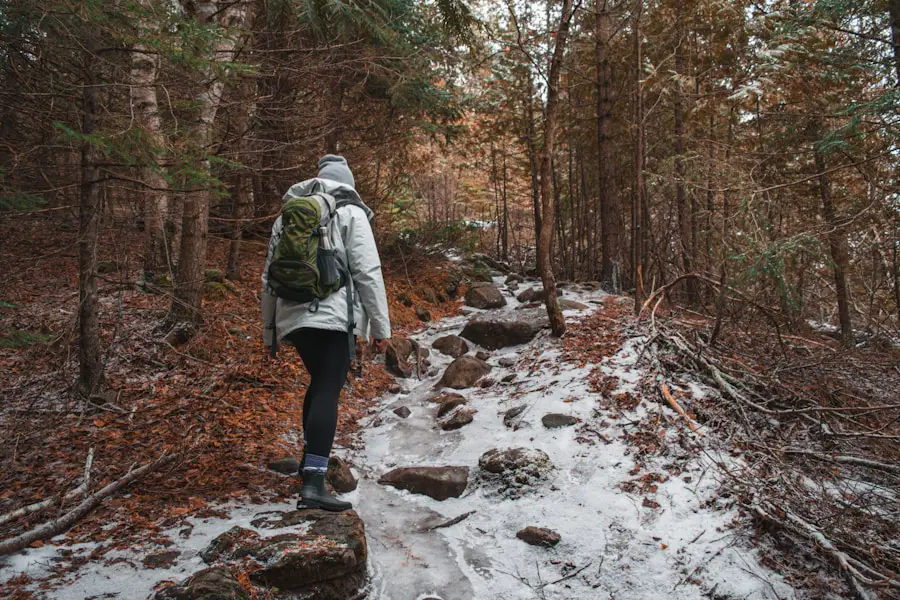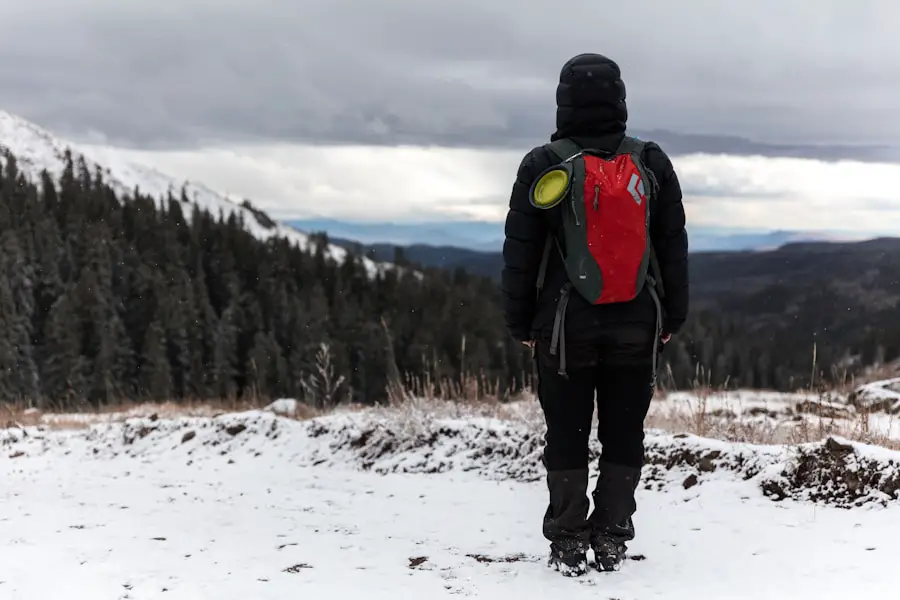Layering clothing is a fundamental strategy for staying warm and comfortable in cold weather. The principle behind layering is to create a system of insulation that can be adjusted according to the temperature and activity level. The base layer, which is worn closest to the skin, plays a crucial role in moisture management.
Fabrics such as merino wool or synthetic materials like polyester wick moisture away from the body, keeping the skin dry and preventing chills. A well-fitted base layer can also provide a snug fit that retains body heat without adding bulk. The middle layer serves as insulation, trapping heat while allowing moisture to escape.
Fleece jackets, down vests, or synthetic insulated jackets are popular choices for this layer. The outer layer, or shell, protects against wind, rain, and snow. Waterproof and breathable materials like Gore-Tex or similar fabrics are ideal for this purpose.
By combining these layers, individuals can easily adjust their clothing to accommodate changes in temperature or activity level, ensuring comfort throughout the day. For instance, during a vigorous hike, one might remove the middle layer to prevent overheating, while on a stationary break, adding it back can help retain warmth.
Key Takeaways
- Layering clothing is essential for staying warm in cold weather, as it traps heat and allows for easy adjustment as temperatures change.
- Insulated waterproof boots are a must-have for keeping feet warm and dry in snowy or wet conditions.
- Thermal socks provide extra insulation and moisture-wicking properties to keep feet warm and comfortable.
- Gloves and mittens are crucial for protecting hands from the cold, and it’s important to choose a pair that is both insulated and waterproof.
- A warm hat is essential for retaining body heat, as a significant amount of heat can be lost through the head.
Insulated Waterproof Boots
When venturing into cold and wet environments, insulated waterproof boots are essential for maintaining warmth and comfort. These boots are designed with materials that provide both insulation and protection from moisture. Look for boots that feature a waterproof membrane, such as Gore-Tex, which allows sweat to escape while keeping water out.
Insulation materials like Thinsulate or fleece linings help trap heat, ensuring that feet remain warm even in frigid conditions. The construction of insulated waterproof boots also plays a significant role in their effectiveness. A high shaft can prevent snow from entering the boot, while a sturdy sole provides traction on slippery surfaces.
Brands like Sorel and Columbia offer a range of options that combine style with functionality. For example, the Sorel Caribou boot is renowned for its durability and warmth, making it a favorite among winter enthusiasts. Investing in quality insulated waterproof boots not only enhances comfort but also reduces the risk of frostbite and other cold-related injuries.
Thermal Socks

Thermal socks are an often-overlooked component of winter attire that can significantly impact overall warmth and comfort. Unlike regular cotton socks, thermal socks are crafted from specialized materials designed to provide insulation while wicking moisture away from the skin. Wool is a popular choice due to its natural insulating properties and ability to retain warmth even when damp.
Merino wool, in particular, is favored for its softness and breathability, making it ideal for extended wear. In addition to material, the thickness and fit of thermal socks are crucial for optimal performance. A thicker sock can provide additional cushioning and warmth but may require larger footwear to avoid constriction.
Conversely, thinner thermal socks can be worn with snug-fitting shoes for better circulation. Brands like Smartwool and Darn Tough offer a variety of thermal sock options tailored for different activities, from hiking to skiing. Choosing the right thermal sock can make a significant difference in foot comfort during cold weather excursions.
Gloves and Mittens
| Year | Global Sales (in million pairs) | Market Share (%) |
|---|---|---|
| 2018 | 1,200 | 15 |
| 2019 | 1,350 | 17 |
| 2020 | 1,500 | 19 |
| 2021 | 1,650 | 21 |
Keeping hands warm in cold weather is essential for overall comfort and functionality, making gloves and mittens critical accessories. The choice between gloves and mittens often comes down to personal preference and intended use. Gloves provide dexterity, allowing individuals to perform tasks such as handling gear or using a smartphone without removing them.
However, mittens offer superior warmth by allowing fingers to share heat, making them ideal for extremely cold conditions. When selecting gloves or mittens, consider materials that provide both insulation and waterproofing. Many modern options incorporate synthetic insulation like Primaloft or down fill for warmth while using waterproof membranes to keep hands dry.
Additionally, features such as adjustable cuffs can help seal out cold air and snow. Brands like The North Face and Hestra offer high-quality options that cater to various activities, from skiing to winter hiking. Investing in a good pair of gloves or mittens can enhance outdoor experiences by ensuring that hands remain warm and functional.
Warm Hat
A warm hat is an indispensable accessory for anyone braving cold weather conditions. The head is a significant area through which body heat escapes; therefore, wearing an insulated hat can help retain warmth effectively. Materials such as wool or fleece are excellent choices for hats due to their insulating properties and ability to wick moisture away from the skin.
A well-fitted hat should cover the ears and fit snugly without being overly tight. In addition to material and fit, the design of the hat can also impact its effectiveness. Beanies are popular for their versatility and style, while earflap hats provide extra protection against biting winds.
Some hats even come equipped with features like built-in ear warmers or reflective elements for visibility in low-light conditions. Brands like Patagonia and Columbia offer a range of options that combine functionality with fashion. A warm hat not only enhances comfort but also contributes significantly to overall body warmth during outdoor activities.
Insulated Water Bottle

Key Features to Look For
Stainless steel insulated bottles are particularly effective due to their durability and thermal retention capabilities. When choosing an insulated water bottle, look for features such as a wide mouth for easy filling and cleaning, as well as a leak-proof lid to prevent spills during transport. Some bottles even come with double-wall vacuum insulation technology that minimizes heat transfer, keeping drinks hot for hours on end.
Popular Brands for Outdoor Enthusiasts
Brands like Hydro Flask and YETI have gained popularity for their high-quality insulated bottles that cater to outdoor enthusiasts. Carrying an insulated water bottle filled with hot tea or cocoa can provide not only hydration but also a comforting source of warmth during cold-weather adventures.
Stay Warm and Hydrated
An insulated water bottle can be a lifesaver during cold-weather activities, providing a convenient and comforting way to stay hydrated and warm.
Hand Warmers
Hand warmers are small yet effective tools for combating cold hands during outdoor activities. These portable devices come in various forms, including disposable chemical warmers and reusable electric options. Disposable hand warmers typically contain iron powder that oxidizes when exposed to air, generating heat for several hours.
They are lightweight and easy to carry, making them ideal for short outings or emergencies. On the other hand, reusable electric hand warmers offer a sustainable option for those who spend extended periods outdoors. These devices can be charged via USB and provide adjustable heat settings for personalized comfort.
Some models even double as power banks for charging electronic devices on the go. Brands like HotHands and Ocoopa offer a range of hand warmer options suitable for different needs and preferences. Incorporating hand warmers into your winter gear can significantly enhance comfort levels during outdoor activities by providing instant warmth at your fingertips.
Emergency Supplies
When venturing into cold environments, being prepared with emergency supplies is crucial for safety and survival. Weather conditions can change rapidly, and having the right gear can make all the difference in an emergency situation. A well-stocked emergency kit should include items such as a first aid kit, flashlight with extra batteries, multi-tool or knife, and emergency blankets designed to retain body heat.
In addition to these essentials, consider including food items that are high in energy but lightweight, such as energy bars or nuts. A whistle can also be invaluable for signaling for help if needed. It’s important to regularly check your emergency supplies to ensure everything is functional and within expiration dates.
Brands like Adventure Medical Kits offer comprehensive first aid kits tailored for outdoor adventures, while companies like SOL (Survive Outdoors Longer) provide compact emergency kits designed specifically for survival situations in the wilderness. Being equipped with emergency supplies not only enhances safety but also provides peace of mind when exploring cold-weather environments.
When preparing for a cold weather hike, it’s important to not only dress appropriately but also pack the right gear. One essential item to consider bringing along is a pair of compact binoculars for hiking, which can enhance your outdoor experience by allowing you to observe wildlife and scenic views up close. For a comfortable night’s sleep during your backpacking trip, investing in the best sleeping bag is crucial to staying warm and cozy. Additionally, don’t forget to pack universal travel adapters for your spring 2025 adventures to ensure you can charge your devices wherever you go. These must-have items will help you make the most of your cold weather hiking experience. Check out this article for more information on compact binoculars for hiking.
FAQs
What should I wear for hiking in cold weather?
When hiking in cold weather, it’s important to wear layers to stay warm and dry. Start with a moisture-wicking base layer, add an insulating layer, and finish with a waterproof and windproof outer layer.
What materials are best for hiking in cold weather?
For base layers, choose moisture-wicking materials such as merino wool or synthetic fabrics. Insulating layers should be made of materials like fleece or down, and outer layers should be waterproof and windproof, such as Gore-Tex or similar materials.
What type of pants are suitable for hiking in cold weather?
For hiking in cold weather, it’s best to wear insulated and waterproof pants to keep your legs warm and dry. Look for pants made of materials like Gore-Tex or similar waterproof and breathable fabrics.
What kind of footwear is recommended for hiking in cold weather?
For hiking in cold weather, it’s important to wear waterproof and insulated hiking boots to keep your feet warm and dry. Look for boots with good traction to prevent slipping on icy or snowy trails.
What accessories should I bring for hiking in cold weather?
Accessories such as a warm hat, gloves or mittens, a scarf or neck gaiter, and sunglasses are essential for hiking in cold weather. It’s also important to bring extra socks, hand warmers, and a backpack cover to protect your gear from snow and moisture.
